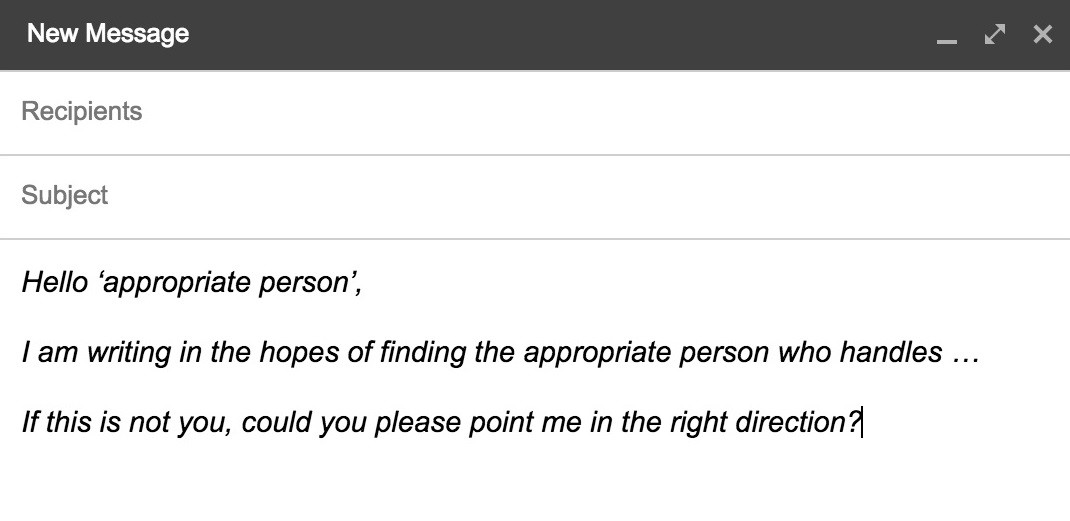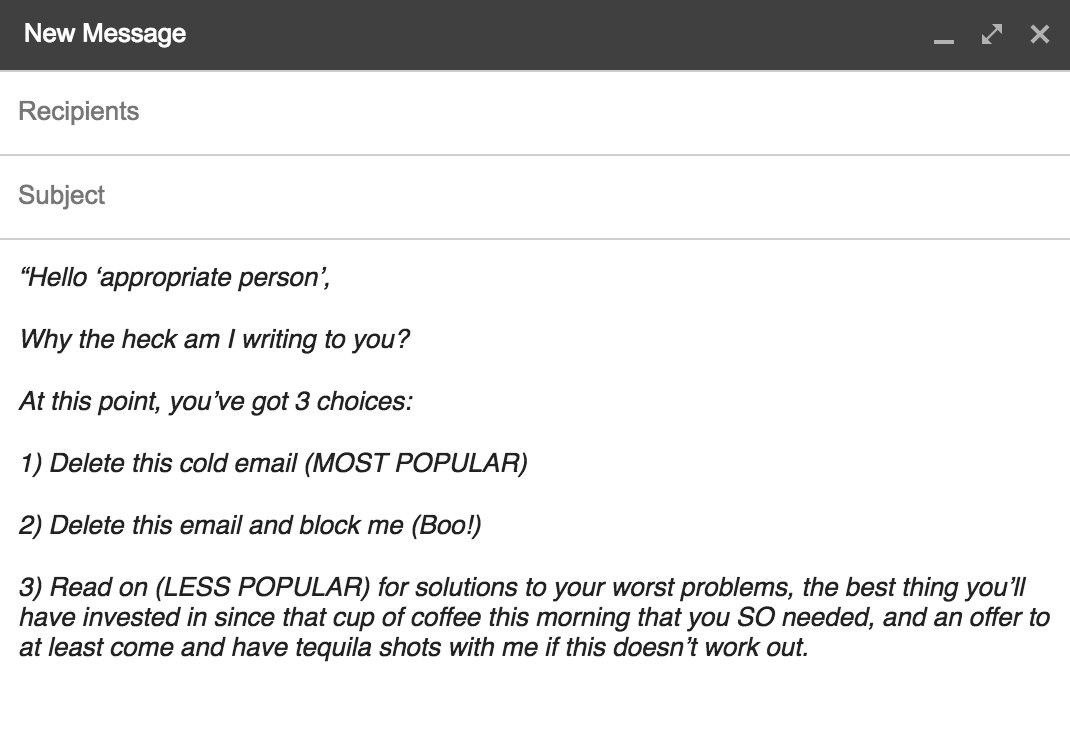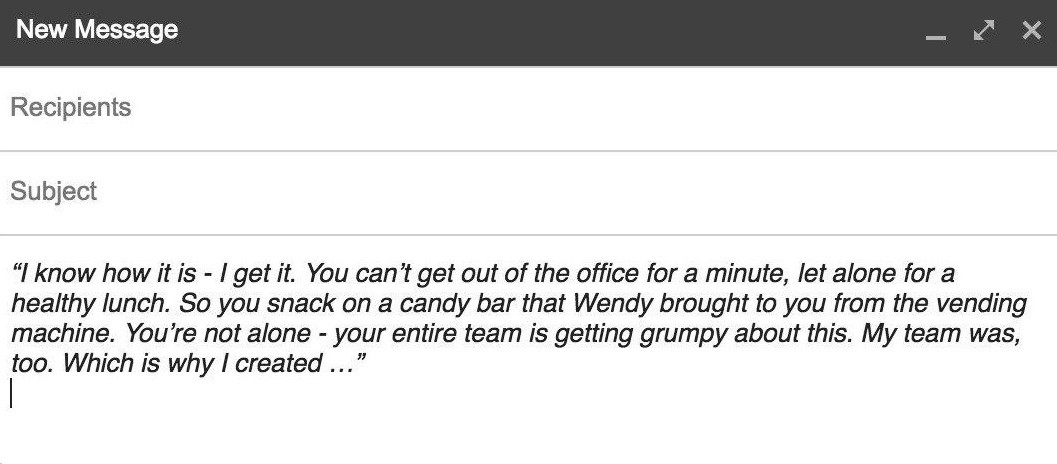Top 4 Tricks Crafting an Actually Effective Cold Email for a Warm Response

Mastering Cold Emails for Small Businesses
Cold emails: No one wants to read them. Each time a business owner receives another unsolicited email, they shake their heads and instantly press delete, right?
Wrong.

Cold emails are first and foremost necessary for small businesses like yours — and if they come with a terrific offer, the recipient is only too pleased to open them up and read. After all, we’ve all got problems that need solving. And if a stranger in an email is offering to solve them, why wouldn’t we hear them out?
Sure, there’s plenty of doom and gloom surrounding cold emails, and the average conversion rate is pretty woeful — just 0.5%.
If it’s that bad, what’s the point in sending them out?
Two reasons:
- Small businesses have to send cold emails — it’s one of the best ways to acquire new customers.
- Who cares about average when you can do what Fast Company, Lead Genius, and Kyle Gawley did and massively improve both your open and your conversion rates to something insane like 86%?
Let’s take a look at how to write short and effective cold emails.
1. Be personable, original, and funny
Each time you write a cold email, put yourself in the position of the recipient: They’ve probably had a long day, and they’ve already deleted 20 of the worst unsolicited emails ever.
These emails were focused purely on selling, and it made the recipient feel resentful.
“If I get one more of these crummy emails, I’m gonna delete the entire computer!”
For your email, you’re going to try a different approach. Instead of spending all your time selling, pitching, and persuading, be personable instead. Focus on communicating and being impactful by being human, nice — and most importantly of all, funny.
Funny makes people smile. It helps to build rapport. Instead of yet another faceless, corporate drone who wants their cash, you’re suddenly someone who’s brightening their day!
And by being funny, you’ve also got a chance of your whole email being read.
Consider these two contrasting examples:


The first example tells the recipient straight away to expect a sales pitch, which is a major turn-off.
The second example is creative, inventive, different, and humorous. It will raise an eyebrow, grab their attention — and there’s a huge chance they’ll read on.
Remember, the aim of all cold email marketing campaigns is to get the emails read, and the aim of the first few lines is to get the next few lines read.
2. Get your subject line right
It’s generally accepted that 30% is the average open rate for cold emails.
That means 3 out of 10 people will probably open your unsolicited emails.
That doesn’t seem too bad, but:
- It could be better
- To even get a 30% open rate, your subject line has to be good.
There are literally so many different types of subject lines you can use, and truth be told you’ll need to do a lot of split testing to see what works for you and what doesn’t. However, there are a few tactics you can employ that usually guarantee good results.
The curious subject line
According to the curiosity-drive theory, humans hate feeling uncertain about anything. When something happens that we’re unsure about, we get anxious.
We can apply this rationale to anything, from a missing person to a strange email subject line.
Consider the below example:

Put yourself in the recipient’s shoes:
“Cut to the chase about what?!”
People don’t want to remain uncertain. And since clearing this particular uncertainty up involves a simple click, the recipient is likely to go ahead and open the email.
The insanely original and humorous subject line
Fresh for 2018 in cold email marketing is originality and humor. We’ve already touched on being original in the copy body of your email, but you also need to be original with the subject line.
Consider this highly original, irreverent, and possibly even irrelevant (who cares?!) subject line:

Recipients be like: “What? Let me just open that…”
The referral subject line
This one is only possible if you’ve actually been forwarded someone’s email address by someone they know. But if you have, by gosh, leverage it.
For example:

Robert Cialdini already covered why name dropping is so effective in cold calling in his book The Psychology of Persuasion, and it’s a technique that never gets old.
Primarily, it helps to establish trust between you and the recipient — two strangers who have never met before. And trust is very important if your unsolicited email is going to be opened.
3. Build a relationship
When you send a cold email to a recipient, said recipient is, well, cold.
It’s your job to warm them up. And you do this with your copy.
Salesy pitches just don’t cut it anymore. If it’s clear that you’re here to sell and would instantly run to the next person if the recipient doesn’t seem interested, the recipient is going to think “good for you,” before getting on with their day.
Which isn’t what you want.
Instead, what you need to do is focus on relationship-building. This isn’t easy to do, especially for short emails to total strangers who you do want to sell to. However, there are ways to do it.
The first thing you need to do is be personable, as we mentioned earlier. This helps to establish trust and confidence in you, which is super important. Remember, a prospect has to trust you and your product.
The second thing you need to do is provide as much value as possible. Highlight their problem before showing them via storytelling how you’re going to solve it for them. Walk them through the process (as briefly as possible). Show them why they can trust you. Produce numbers.
A simple line like this instills so much confidence in someone:
“I boosted another client’s conversion rates by 7.2%.”
The third thing you need to do is provide the recipients with benefits. The whole time someone is reading your email, this is what they’ll be thinking:
“Yeah, yeah, yeah. But what’s in it for me?”
Forget features for now — few people care about that at this point. What a prospect wants to know is what your product or service is going to do for them.
4. Get straight to the point
The easiest way to break rapport with a prospect and make them stop reading?
Feed them BS. Make ludicrous, wild statements. Lead them on a merry dance with pointless, boring anecdotes.
Look, recipients are short on time. They want you to get straight to the point.
As soon as possible, identify their pain points. Pain is bad and creates a sense of urgency. Tease them for a line or two with this pain point and make them feel a bit miserable, before hitting them with how you’re going to solve their pain points for them.
Example:

We can structure a to-the-point cold email formula like this:
- Intro
- Pain points
- Cure
- Call to action
There’s no magic bullet for writing cold emails, but there are ways to do it that work better than others. Keep this structure in mind and fill the copy body with engaging, personable, and — where permissible — funny language. Don’t be boring. Don’t be salesy. And offer lots of value.
Have any tips of your own? Let us know in the comments below!
Newsletter
Subscribe to our newsletter
Join our newsletter to be the first to access Nightwatch's cutting-edge tools, exclusive blog updates, and fresh wiki insights. Transform your online presence today!
